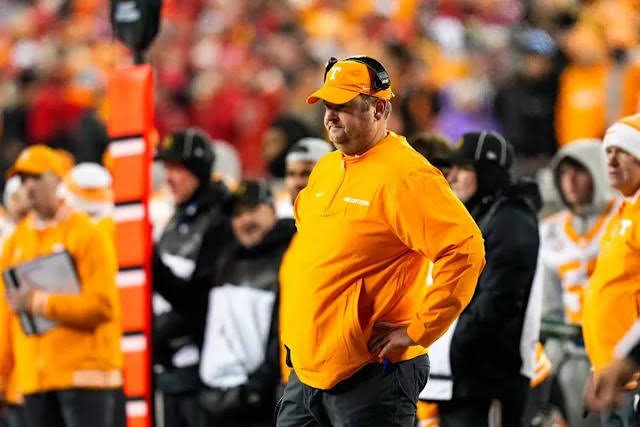
Mingle with Tennessee football fans long enough, and you’ll hear the debate.
Is Josh Heupel’s coaching staff good or bad at recruiting? Are his coaches good or bad at developing players? Are they good or bad at evaluating talent in the transfer portal?
It’s a binary argument: Pass or fail. But it shouldn’t be.
And the 2025 NFL Draft showed that.
Edge rusher James Pearce went to the Atlanta Falcons in the first round. He was a Heupel recruit.
Coaches who can’t recruit, develop or evaluate players don’t produce NFL talent like that.
That’s a notch in the win column for any UT fan having that debate. But, again, it’s not so clear-cut.
Why Josh Heupel draft classes don’t win the debate
Sure, four Heupel players were selected in the 2025 NFL Draft. Five UT players were taken early in the 2023 draft, including some who Heupel inherited from Jeremy Pruitt’s tenure and developed into NFL players.
It marks the second time in three years that UT has had at least four players drafted in the first four rounds. The last time that happened twice in a three-year stretch was in back-to-back drafts in 2002-03.
That’s pretty good. But here’s the counterpoint: Why didn’t UT have five or six or seven players drafted this year? Or why didn’t it have multiple first-rounders?
During the Vols’ draft heyday, they produced nine first-round picks in five years (1998 to 2002), ranging from Peyton Manning to Albert Haynesworth. Phillip Fulmer’s staff coached them.
Johnny Majors’ staff rivaled that hot streak by producing nine first-round picks in eight years (1982-89).
In the 2002 draft, UT had 10 players selected in one of the best classes of all time. That included first-rounders Haynesworth, John Henderson and Donté Stallworth.
That talent was great in terms of quality and quantity. Heupel’s talent has been good in both quality and quantity.
And that’s why there’s so much nuance in judging Heupel as a championship roster builder.
UT’s roster has turned over from Pruitt recruits to Heupel recruits, and there are some concerns that the talent level won’t be sustained.
The 2024 season was the first under Heupel that the majority of starters (16 of 22) were those he brought to UT. But there were other notable players from the Pruitt era filling out the depth chart.
In the 2025 season, defensive linemen Bryson Eason and Dominic Bailey will be the only remaining players from the Pruitt era. Notably, they’re both considered NFL prospects.
But All-America cornerback Jermod McCoy also could be a 2026 draft pick if he recovers from a torn ACL. Edge rusher Joshua Josephs could be selected, and there are a few other possible draft picks.
They are recruits and transfers handpicked by Heupel’s staff
Why debate over Josh Heupel performance is unwinnable
So you see there are valid points on both sides. For every supposed rule about Heupel’s recruiting and player development, there are obvious exceptions.
Heupel’s recruiting classes rank in the top 15 but not in the top five.
Heupel’s portal pickups almost always pan out, at least as contributors. But the Vols usually aren’t in the mix for the top transfers. They get second- and third-tier players and maximize their talent.
Heupel’s staff developed Heisman Trophy candidate Hendon Hooker and Biletnikoff winner Jalin Hyatt. It turned three-star recruit Sampson into the SEC Offensive Player of the Year and four-star recruit Pearce into a first-round pass rusher.
But it didn’t get the most out of five-star quarterback Nico Iamaleava. Five-star receiver Mike Matthews wasn’t an immediate success as a freshman. And LSU transfer Lance Heard didn’t play like a former five-star recruit last season.
If Heupel got a letter grade as a recruiter, developer and evaluator, it might be a B-minus.
His Rotten Tomatoes score would be above 80%. He’d get a four-star rating but not five. He’d get one-and-a-half thumbs up but not two.
And that’s why arguments about Heupel’s performance in these roster-building areas is unwinnable. More data is needed. More time is needed. More football is needed.
But he has definitely passed in far more areas than he has failed. Four draft picks in four rounds, all handpicked and coached by Heupel’s staff, make that case






